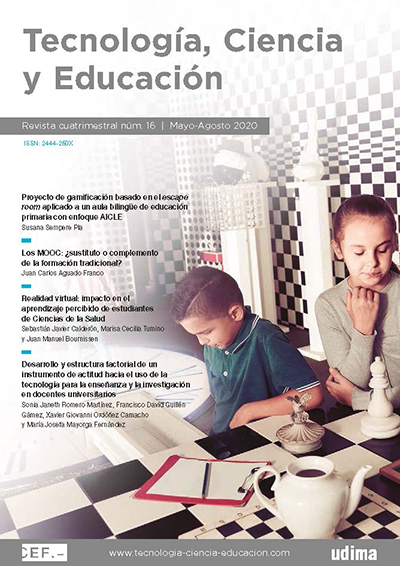Sistema SCADA adaptado para el control de la alimentación en animales de laboratorio
DOI:
https://doi.org/10.51302/tce.2020.447Palabras clave:
ratas, sistema de bajo coste, control de alimentación, Arduino®, inalámbricoResumen
Las instalaciones dedicadas al alojamiento de animales de laboratorio son cada vez más complejas. No solo deben garantizar las necesidades básicas y el bienestar de los animales alojados, sino que también deben permitir la realización de la variedad de procedimientos experimentales que tienen lugar en ellas.
Debido a la dificultad de implementación y al alto coste de los sistemas automáticos de alimentación, el uso de los mismos se ha limitado prácticamente a grandes instalaciones, siendo manual el suministro de dietas en la mayoría de centros. No obstante, debido al incremento de procedimientos experimentales que incluyen algún tipo de restricción alimentaria y, principalmente, a las ventajas en roedores de la alimentación restringida frente a la alimentación ad libitum (AL) en estudios a largo plazo, el grado de sofisticación de los sistemas automáticos de alimentación para animales de experimentación es superior a los de otras especies.
Dado el estado de crecimiento de este sector, surge la idea de desarrollar e implementar un dispensador de dieta de bajo coste para roedores de experimentación. En este trabajo se plantea el desarrollo de un prototipo, a partir de un sistema SCADA (supervisory control and data acquisition). El usuario accederá al control del equipo a través de una interfaz de fácil instalación y uso. El SCADA permitirá la dosificación del alimento según un programa-horario establecido y el registro de la ingesta en tiempo real. Esta solución de bajo coste establecerá una propuesta competitiva y de uso extensivo en el mercado.
Descargas
Citas
Bains, R. S., Cater, H. L., Sillito, R. R., Chartsias, A., Sneddon, D., Concas, D., Keskivali-Bond, P., Lukins, T. C., Wells, S., Nolan, A. y Armstrong, P.M. (2016). Analysis of individual mouse activity in group housed animals of different in bred strains using a novel automated home cage analysis system. Frontiers in Behavioral Neuroscience, 10, 106.
Balcombe, J. P., Barnard, N. D. y Sandusky, C. (2004). Laboratory routines cause animal stress. Journal of the American Association for Laboratory Animal, 43(6), 42-51.
Bolaños, F., LeDue, J. M. y Murphy, T. H. (2017). Cost effective raspberry pi-based radio frequency identification tagging of mice suitable for automated in vivo imaging. Journal of Neuroscience Methods, 276, 79-83.
Carney, E. W., Zablotny, C. L., Marty, M. S., Crissman, J. W., Anderson, P., Woolhiser, M. y Holsapple, M. (2004). The effects of feed restriction during in utero and postnatal development in rats. Toxicological Science: An Official Journal of the Society of Toxicology, 82(1), 237-249.
Chacón, F., Esquifino, A. I., Perelló, M., Cardinali, D. P., Spinedi, E. y Álvarez, M. P. (2005). 24-hour changes in ACTH, corticosterone, growth hormone, and leptin levels in young male rats subjected to calorie restriction. Chronobiology International, 22(2), 253-265.
Duffy, P., Lewis, S. M., Mayhugh, M. A., Trotter, R. W., Thorn, B. T., Feuers, R. J. y Turturro, A. (2004). The effects of different levels of dietary restriction on non-neoplastic diseases in male Sprague-Dawley rats. Aging Clinical and Experimental Research Aging, 16(1), 68-78.
Duffy, P. H., Lewis, S. M., Mayhugh, M. A., Trotter, R. W., Latendresse, J. R., Thorn, B. T. y Feuers, R. J. (2004). The effects of different levels of dietary restriction on neoplastic pathology in the male Sprague-Dawley rat. Aging Clinical and Experimental Research, 16(6), 448-456.
Feuers, R. (1991). The relationship of dietary restriction to circadian variation in physiologic parameters and regulation of metabolism. Aging, 3(4), 399-401.
González-Esquiva, J. M., Oates, M. J., García Mateos, G., Moros-Valle, B., Molina-Martínez, M., Ruiz-Canales, A. (2017). Development of a visual monitoring system for water balance estimation of horticultural crops using low cost cameras. Computers and Electronics in Agriculture, 141, 15-26.
Goulding, E. H., Schenk, A. K., Juneja, P., MacKay, A. W., Wade, J. M. y Tecott, L. H. (2008). A robust automated system elucidates mouse home cage behavioral structure. Proceeding of the National Academy of Sciences of the United States of America, 105(52), 20.575-20.582.
Hubert, M., Laroque, P., Gillet, J. y Keenan, J. P. (2000). The effects of diet, ad libitum feeding, and moderate and severe dietary restriction on body weight, survival, clinical pathology parameters, and cause of death in control Sprague-Dawley rats. Toxicological Science: An Official Journal of the Society of Toxicology, 58, 195-207.
Keenan, K. P., Laroque, P. y Dixit, R. (1998). Need for dietary control by caloric restriction in rodent toxicology and carcinogenicity studies. Journal of Toxicology and Environmental Health, Part B, Critical Review, 1, 135-148.
Keenan, K. P., Laroque, P., Ballam, G. C., Soper, K. A., Dixit, R., Mattson, B. A., Adams, S. P. y Coleman, J. B. (1996). The effects of diet, ad libitum overfeeding, and moderate dietary restriction on the rodent bioassay: the uncontrolled variable in safety assessment. Toxicological Pathology, 24(6), 757-768.
Kemppinen, N., Meller A., Mauranen, K., Kohila, T. y Nevalainen, T. (2008). Work for food-A solution to restricting food intake in group housed rats? Scandinavian Journal of Laboratory Animal Science, 35(2), 81-90.
Leakey, J. E. A., Seng, J. E. y Allaben, W. T. (2003). Body weight considerations in the B6C3F1 mouse and the use of dietary control to standardize background tumor incidence in chronic bioassays. Toxicology and Applied Pharmacology, 193(2), 237-265.
Masoro, E. J. (1995). Design issues in the use of the diet-restricted rodent model. En R. W. Hart, D. A. Neumann, R. T. Robertson (Eds.), Dietary Restriction: Implications for the Design and Interpretation of Toxicity and Carcinogenicity Studies (1.ª ed., pp. 41-50). Washington DC, EE: UU.: LSI Press.
Masoro, E. J. (2005). Overview of caloric restriction and ageing. Mechanisms of Ageing and Development, 126(9), 913-922.
Molina Martínez, J. M., Ruiz-Canales, A., Jiménez-Buendía, M., Soto, F. y García Fernández-Pacheco, D. (2014). SCADA platform combined with a scale model of trickle irrigation system for agricultural engineering education. Computer Applications in Engineering Education, 22(3).
Murphy, T. H., Boyd, J. D., Bolaños, F., Vanni, M. P., Silasi, G., Haupt, D. y Ledue, J. M. (2016). High-throughput automated home-cage mesoscopic functional imaging of mouse cortex. Nature Communicantions, 7.
Naoto I. (26 de junio de 2015). Development of balance for animals. A & D Discover Precision. Recuperado de http://www.aandd.jp/support/devstories/story35.html (consultado el 29 de noviembre de 2019).
Pickering, R. G. y Pickering, C. E. (1984). The effects of reduced dietary intake upon the body and organ weights, and some clinical chemistry and haematological variates of the young Wistar rat. Toxicology Letters, 21(3), 271-277.
Richardson, C. A. (2015). The power of automated behavioural homecage technologies in characterizing disease progression in laboratory mice: a review. Applied Animal Behaviour Science, 163, 19-27.
Ritskes-Hoitinga, M. y Savenije, B. (2008). The power of moderate food restriction (Abstract). En C. Bernadi, M. R. Gamble (Eds.), Proceedings of the Tenth FELASA Symposium and the XIV ICLAS General Assembly & Conference, 11-14 de junio de 2007, Cernobbio, Italia. Londres, Inglaterra, Reino Unido: Royal Society of Medicine Press.
Roe, F. J., Lee, P. N., Conybeare, G., Kelly, D., Matter, B., Prentice, D. y Tobin, G. (1995). The biosure study: influence of composition of diet and food consumption on longevity, degenerative diseases and neoplasia in wistar rats studied for up to 30 months post weaning. Food and Chemical Toxicology, 33(1), S1-S100.
Russell, W. M. S. y Burch, R. L. (1959). The Principles of Humane Experimental Technique (1.ª ed.). Londres, Inglaterra, Reino Unido: Methuen.
Scott, B. B., Brody, C. D. y Tank, D. W. (2013). Cellular resolution functional imaging inbehaving rats using voluntary head restraint. Neuron, 80(2), 371-384.
Snyder, D. L. y Towne, B. (1989). The effect of dietary restriction on serum hormone and blood chemistry changes in aging Lobund Wistar rats. Progress in Clinical and Biological Research, 287, 135-146.
Spiteri, N. J. (1982). Circadian patterning of feeding, drinking and activity during diurnal food access in rats. Physiology & Behavior, 28(1), 139-147.
Turturro, A., Duffy, P. H. y Hart, R. W. (1993). Modulation of toxicity by diet and dietary macronutrient restriction. Mutation Research, 295(4-6), 151-164.
Ulman, E. A., Compton, D. y Kochanek, J. (2008). Measuring food and water intake in rats and mice. ALN Magazine, 12, 17-20.
Descargas
Publicado
Cómo citar
Número
Sección
Licencia
Derechos de autor 2020 Julia María Samos Juárez, Jorge Juan Rosillo Olmos, Antonio Ruiz Canales

Esta obra está bajo una licencia internacional Creative Commons Atribución-NoComercial-SinDerivadas 4.0.


























